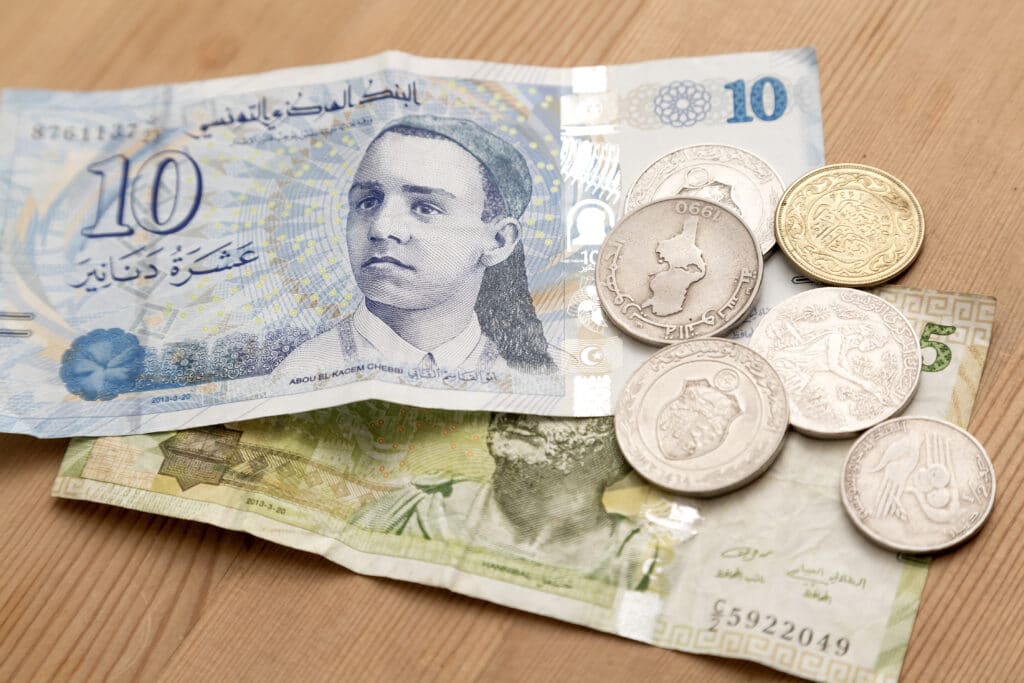The Tunisian dinar (TND) is more than just a currency. It represents Tunisia’s rich history, evolving economy, and the strength of its people. Whether you are a traveler, expat, or investor seeking to understand the nuances of this currency, you’re in the right place. This blog will explore what you need to know about the Tunisian dinar, from its origins and current value to its impact on everyday life and trade. You’ll also learn how to manage its fluctuations if you’re planning to spend, invest, or transfer money in Tunisia.
What Is the Tunisian Dinar?
The Tunisian dinar (TND) is the official currency of Tunisia, a North African country located on the Mediterranean coast. The dinar is subdivided into millimes (1 dinar = 1,000 millimes) and has been a stable medium of exchange for decades.
Tunisia introduced its own currency, the dinar, in 1960, replacing the French franc previously in circulation during French colonial rule. Named after the ancient Roman coin, the “denarius,” the dinar echoes the country’s long-standing ties to Mediterranean trade and culture.
Key Features of the Tunisian Dinar
Here are some essential details about the Tunisian dinar that enhance its uniqueness and usability in everyday life and trade.
1. Banknotes and Coins
Tunisian dinar banknotes are issued in denominations ranging from 5 to 50 dinars, with coins issued in smaller denominations of millimes. Tunisians mainly use coins for daily transactions, such as buying a coffee or groceries.
One thing to note for visitors is that Tunisian currency is highly controlled. You cannot export or import dinars (carry them outside or into Tunisia), meaning all exchanges must occur within the country.
2. Currency Restrictions
The Tunisian central bank enforces strict regulations on the dinar to control its value and protect local economic interests. Non-residents are required to exchange unused dinars back to their original currency upon departure.
3. Fixed and Free Market Rates
The dinar operates both on an official exchange rate offered by banks in Tunisia and on less formal parallel markets. Travelers and investors should ensure they rely on official channels for transparency and competitive rates.
Current Value of the Tunisian Dinar
The Tunisian dinar’s value fluctuates depending on economic policies, demand, external debt, and the broader global economy. Currently, US dollars (USD), Euros (EUR), and other major currencies hold significant influence over exchange rates.
Currency Exchange Considerations
- Strength Against USD/EUR: Exchange rates can vary depending on the strength of foreign currencies.
- Tourism Industry Impact: Tunisia’s reliance on tourism and its economic fluctuations can also affect the dinar’s value.
If you’re involved in trade, tourism, or investments in Tunisia, monitoring current exchange rates regularly is key.
The Tunisian Dinar in Everyday Life
For the average Tunisian, daily life revolves around using the dinar in markets, transportation, and services. It also influences purchasing power and economic stability, particularly for those reliant on fixed incomes or small businesses.
Key industries like agriculture, textiles, oil, and tourism also depend on the stability of the dinar to remain competitive in international markets.
Why the Tunisian Dinar Matters for Travelers and Expats
If you’re planning a visit or relocating to Tunisia, here are some critical tips to manage your finances in dinars effectively.
1. Currency Exchange
Most exchanges happen at banks, airports, or official currency exchange offices. You may need your passport and receipts if you need to convert unused dinars back to the original currency. Never exchange money on the black market.
2. Use of Local Currency
The dinar is essential for most transactions in Tunisia, from paying for lodging to dining at local restaurants. International cards are accepted in higher-end establishments, but for day-to-day purchases, cash is king.
3. Budgeting for Daily Life
Tunisia is relatively affordable compared to many Western countries. Knowing the value of the dinar can help you set realistic daily budgets for food, accommodations, and transport.
The Role of the Tunisian Dinar in International Trade
Trade and Exports
The Tunisian dinar plays a critical role in Tunisia’s export-driven economy, with goods like olive oil, textiles, and phosphates among the key exports.
International Partnerships
Tunisia’s trade relationships with the European Union, especially France and Italy, bring in significant foreign currency. The dinar’s exchange rate with these currencies can have a direct economic impact.
Managing Currency Risks with TND
For investors, businesses, and frequent travelers, managing risks associated with the dinar’s fluctuation is crucial. Here’s how you can do it right.
Currency Hedging
Forex markets may allow businesses to hedge major exchange risks when dealing with the dinar and minimize financial uncertainty.
Using Remittance Services
Online platforms like Remitly allow you to send and receive money in Tunisia securely and at favorable exchange rates. Check platforms that are transparent, reliable, and align with your currency exchange needs.
A Versatile Currency with Many Influences
Whether you’re exploring its history or handling it for practical reasons, the Tunisian dinar is a currency shaped by Tunisia’s dynamic economic, social, and international trade history.
Understanding its value, functionality, and applications ensures you’re prepared for both the opportunities and complexities it presents.
FAQ
Can I bring Tunisian dinars into or out of Tunisia?
No, Tunisian dinar currency is controlled and cannot be legally exported or imported. All exchanges must occur within the country.
Where is the best place to exchange Tunisian dinars?
The best options are banks, airports, or official exchange offices in Tunisia. Avoid black-market exchanges as they are illegal and risky.
How is the dinar’s value determined?
The dinar’s value depends on demand, economic policies, and global markets, particularly the strength of foreign currencies like USD and EUR.
What cash denominations are commonly used in Tunisia?
Coins in millimes and small bills are commonly used for daily transactions, while larger banknotes like 50 dinars are typically for bigger purchases.
What’s the most effective way to manage currency fluctuations?
Consider using services like online remittance platforms for transparency and competitive rates, or hedging strategies for businesses dealing in large amounts of dinars.


